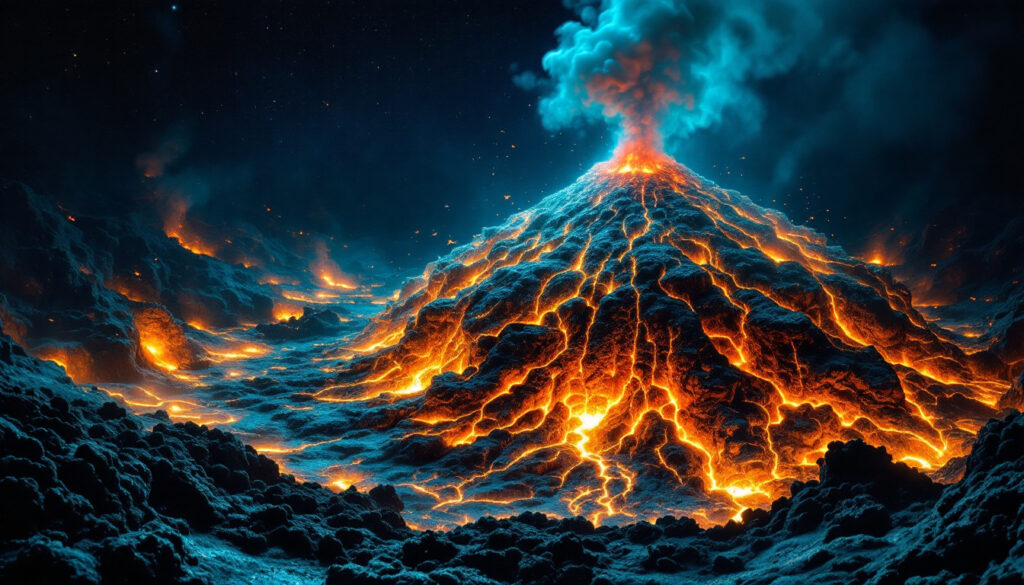What Are Volcanogenic Massive Sulfide Ore Deposits?
Volcanogenic massive sulfide (VMS) ore deposits represent one of the most significant sources of base and precious metals globally. These remarkable geological formations are metal-rich sulfide accumulations that form through complex hydrothermal processes associated with submarine volcanic activity. They stand as crucial sources of copper, zinc, lead, gold, and silver worldwide, with a considerable array of valuable by-products including cobalt, tin, barium, sulfur, selenium, manganese, cadmium, indium, bismuth, tellurium, gallium, and germanium.
VMS deposits are particularly notable for their polymetallic nature, often containing economic concentrations of multiple metals within a single deposit. This characteristic has made them prime exploration targets throughout mining history, as they can remain economically viable even when individual metal prices fluctuate. The typical sulfide content in these volcanogenic massive sulfide ore deposit exceeds 60% by volume, creating distinct high-density bodies that geophysical exploration methods can readily detect.
How Do VMS Deposits Form?
The Genetic Model of VMS Formation
VMS deposits form through a three-stage process that involves the circulation of superheated fluids through volcanic rocks on the seafloor:
-
Source: Metals and sulfur are leached from volcanic rocks in sub-seafloor hydrothermal alteration zones. This process is often driven by heat from deep-seated gabbro intrusions. The metal extraction occurs as seawater penetrates into fractured volcanic rocks, becoming increasingly acidic and capable of dissolving metals from the host rock.
-
Transport: Convection of hydrothermal fluids carries metals and sulfur upward toward the seafloor. Heat supplied by underlying magma chambers draws in cool ocean water, heats it to temperatures exceeding 350°C, and enriches it with metal ions. These metal-laden fluids follow paths of least resistance through fractures and permeable volcanic units.
-
Trap: Ore materials precipitate when hydrothermal fluids are expelled into the ocean through fumarole fields or black smokers. The rapid cooling that occurs when 350-400°C hydrothermal fluids meet near-freezing seawater causes dissolved metals to precipitate as sulfides, forming stratiform deposits on and beneath the seafloor.
Modern Analogues to Ancient Deposits
VMS deposits continue forming today in several tectonic settings around the world:
- Undersea volcanoes along mid-ocean ridges, where new oceanic crust forms
- Back-arc basins behind island arcs, characterized by extensional tectonics
- Forearc rifts, which develop between a volcanic arc and its associated trench
Modern seafloor massive sulfide deposits, such as those found along the East Pacific Rise and the Mid-Atlantic Ridge, provide valuable insights into the formation processes of ancient VMS deposits preserved in the geological record. Studies of active black smoker systems have revolutionized our understanding of how these deposits form, revealing that they can develop remarkably quickly—sometimes in just decades rather than the millions of years once assumed.
What Is the Geology of VMS Deposits?
Typical Geological Setting
VMS deposits typically occur:
- At the top of felsic volcanic sequences within specific stratigraphic horizons
- Within volcaniclastic tuffaceous epiclastics, cherts, sediments, or fine tuffs
- With a more mafic sequence (andesite or basalt) in the hangingwall
- With felsic volcanic rocks spatially and temporally associated, usually in the footwall
- In association with sedimentary rocks, particularly manganiferous cherts that represent chemical precipitates
Recent research has shown that VMS deposits typically form during specific time-limited "metallogenic epochs" rather than continuously throughout geological time. These epochs often correlate with major tectonic reorganizations and periods of enhanced crustal extension.
Deposit Morphology
VMS deposits display various shapes determined by their depositional environment:
- Mound-shaped deposits: Formed similar to modern black smoker chimney accumulations, these grow directly on the seafloor
- Bowl-shaped deposits: Formed by venting of hydrothermal solutions into submarine depressions or craters
- Tabular deposits: Formed in environments dominated by sedimentary rocks or highly permeable volcanic rocks where fluids can spread laterally
The ideal morphological form includes:
- A conical area of highly altered volcanic/volcanogenic sedimentary rock (stringer zone)
- A mound of massive exhalites (up to several tens of meters thick and hundreds of meters in diameter)
- Flanking stratiform exhalative sulfides (apron zone) that extend outward from the central mound
What's particularly interesting is that many ancient VMS deposits show evidence of deformation and metamorphism that can significantly alter their original geometry, making recognition challenging for exploration geologists. Understanding these complexities is essential for investors considering junior mining investments in the sector.
Metal Zonation Patterns
Most VMS deposits show characteristic metal zonation that reflects the temperature gradient away from the hydrothermal vent:
- Core zone: Massive pyrite and chalcopyrite around the vent throat, representing the highest temperature formation environment (>300°C)
- Middle zone: Chalcopyrite-sphalerite-pyrite grading outward as temperatures decrease
- Distal zone: Sphalerite-galena and galena-manganese assemblages forming at lower temperatures (200-250°C)
- Outer zone: Chert-manganese-hematite facies representing the lowest temperature precipitates (<200°C)
- Vertical zonation: Upper portions generally more enriched in gold and silver, while copper often concentrates in the lower portions
The mineralogy consists of over 90% iron sulfide (mainly pyrite), with chalcopyrite, sphalerite, and galena as major economic constituents. Magnetite occurs in minor amounts, particularly in deposits that have undergone metamorphism.
Recent studies have shown that gold distribution in VMS systems is often controlled by later-stage overprinting events, which explains why some VMS deposits are anomalously gold-rich while others of similar size contain minimal precious metals.
Alteration Haloes
VMS deposits create distinctive alteration patterns that are invaluable exploration indicators:
- Conical in shape, expanding downward from the ore body
- Located stratigraphically below the original fluid flow
- Zoned from core outwards:
- Silica alteration zone (most intense), characterized by massive silicification
- Chlorite zone (chlorite ± sericite ± silica), often with anomalous magnesium content
- Sericite zone (sericite ± chlorite ± silica), characterized by potassium enrichment
- Silicification zone (gradational with background silica-albite metasomatism)
These alterations represent metasomatic effects involving potassium, silica, and magnesium addition with sodium depletion. The zonation pattern creates a distinct geochemical signature that extends well beyond the actual ore deposit, providing a much larger exploration target than the deposit itself.
Modern analytical techniques have revealed that these alteration zones also contain distinctive trace element signatures, including thallium, antimony, selenium, and mercury halos that extend even further than the visible alteration mineralogy.
How Are VMS Deposits Classified?
Classification by Host Rock Association
VMS deposits are classified into five subclasses based on their host rock associations, each reflecting distinct tectonic settings and metal endowments:
Mafic-Associated VMS Deposits
- Dominated by mafic rocks, commonly ophiolite sequences representing ancient oceanic crust
- Typically copper-rich with lesser zinc and minimal lead
- Examples: Cyprus and Oman ophiolites, Newfoundland Appalachians
- These deposits generally form at mid-ocean ridges and have the simplest geological setting
Bimodal-Mafic VMS Deposits
- Dominated by mafic volcanic rocks with up to 25% felsic volcanic rocks
- Copper-zinc-rich with variable gold content
- Examples: Noranda, Flin Flon-Snow Lake, and Kidd Creek camps in the Canadian Shield
- These typically form in primitive island arcs and back-arc settings
Mafic-Siliciclastic VMS Deposits
- Sub-equal proportions of mafic volcanic and siliciclastic rocks
- Copper-dominant with elevated cobalt values in some cases
- Examples: Besshi deposits (Japan), Windy Craggy (British Columbia)
- These form in mature back-arc basins with significant sedimentary input
Felsic-Siliciclastic VMS Deposits
- Siliciclastic sedimentary rock-dominated settings with abundant felsic rocks
- Lead-zinc-rich with significant silver and gold
- Examples: Bathurst Mining Camp (New Brunswick), Iberian Pyrite Belt (Spain/Portugal)
- Form in continental margin arcs and back-arcs with substantial continental sedimentary input
Bimodal-Felsic VMS Deposits
- Bimodal sequences where felsic rocks exceed mafic rocks, with minor sedimentary rocks
- Zinc-lead-copper deposits with elevated gold and silver
- Examples: Kuroko deposits (Japan), Buchans deposits (Canada), Skellefte deposits (Sweden)
- Form in evolved island arcs and continental margin arcs
What's particularly significant about this classification is that it allows geologists to predict the likely metal content of newly discovered deposits based on their geological setting, which helps prioritize exploration efforts.
Where Are VMS Deposits Found Globally?
Global Distribution and Tectonic Settings
VMS deposits form throughout geological time in various tectonic settings characterized by extensional tectonics:
- Mid-ocean ridge spreading centers
- Back-arc spreading centers
- Forearc spreading centers
The common theme is association with extensional geodynamic regimes (spreading environments) that facilitate the development of hydrothermal circulation systems. This explains why VMS deposits are often found in ancient volcanic belts that represent former seafloor environments later incorporated into continental masses through plate tectonic processes.
Interestingly, VMS deposits show a non-uniform distribution through geological time, with major peaks of formation during the Archean (2.7 billion years ago), early Proterozoic (1.9 billion years ago), and Phanerozoic (480-360 million years ago) eras. These peaks correspond to periods of major plate reorganization and enhanced rifting activity globally.
Size Distribution and Notable Examples
Most VMS deposits are relatively small:
- Approximately 80% of known deposits range between 0.1-10 million tonnes
- About 10% exceed 15 million tonnes
- Only about 1% qualify as "giant" deposits exceeding 50 million tonnes
Notable examples include:
- Kidd Creek, Ontario, Canada (149 million tonnes at 2.3% Cu, 6.2% Zn, 0.2% Pb, 87 g/t Ag)
- Flin Flon, Manitoba, Canada (777 and Trout Lake Mine)
- Brunswick #12, New Brunswick, Canada (150 million tonnes at 3.4% Pb, 8.4% Zn, 0.4% Cu, 102 g/t Ag)
- Rio Tinto, Spain (one of the oldest continuously mined deposits in the world)
- Greens Creek mine, Alaska, USA (silver-rich VMS with exceptional precious metal grades)
What makes the giant deposits unique is typically the presence of favorable structural traps that allow for prolonged hydrothermal activity or multiple mineralizing events stacked in the same location, essentially creating "VMS districts" rather than isolated deposits.
What Makes VMS Deposits Economically Important?
Economic Significance
VMS deposits represent critical sources of:
- Base metals: copper, zinc, lead
- Precious metals: gold and silver
- Critical minerals: cobalt, tin, indium, tellurium, germanium
- Industrial minerals: barium, sulfur
Their polymetallic nature often allows for economic extraction even when individual metal prices fluctuate. This acts as a natural hedge against price volatility, which is particularly important in today's rapidly changing commodity markets. Additionally, many VMS deposits contain significant concentrations of critical metals essential for green technology, including tellurium (solar panels), indium (touch screens), and germanium (fiber optics).
A less appreciated aspect of VMS deposits is their typically high-grade nature compared to other deposit types. While porphyry copper deposits may contain 0.3-0.8% copper, VMS deposits frequently contain 1-4% copper plus additional metals, making them more economically robust at smaller sizes. Furthermore, these deposits contribute significantly to global top copper mines production trends and will likely feature prominently in mining and finance industry predictions for 2025.
Exploration Challenges and Opportunities
Exploration for VMS deposits involves:
- Identifying ancient submarine volcanic environments through detailed mapping and geochemistry
- Recognizing characteristic alteration patterns that may indicate proximity to mineralization
- Using geophysical methods to detect dense sulfide bodies (some deposits have marked gravity anomalies)
- Applying knowledge from modern seafloor massive sulfide formation to ancient geological settings
One of the most challenging aspects of VMS exploration is that approximately 70% of known deposits show no surface expression, making them "blind" targets that can only be discovered through indirect means. This explains why new VMS discoveries continue to be made in well-explored districts as exploration techniques improve.
Recent innovations in exploration include trace element vectoring using portable XRF technology, analysis of iron oxide compositions to determine proximity to mineralization, and machine learning applications that can identify subtle alteration patterns across large datasets. For investors and mining professionals, understanding these techniques is part of developing a beginner's guide to mining drilling results.
FAQ About Volcanogenic Massive Sulfide Deposits
How do VMS deposits differ from SEDEX deposits?
VMS deposits form in close temporal association with submarine volcanism through hydrothermal circulation independent of sedimentary processes. SEDEX (sedimentary exhalative) deposits form primarily through sedimentary processes with hydrothermal fluids typically derived from basinal brines rather than magmatic sources. A hybrid subclass (VSHMS) shares characteristics of both deposit types.
The key difference lies in heat source and setting: VMS deposits require active volcanism and form proximal to volcanic centers, while SEDEX deposits form in sedimentary basins where heat is provided by crustal thinning and geothermal gradients without direct volcanic input.
What are the typical grades of metals in VMS deposits?
Metal grades vary widely depending on the deposit type, but typically include:
- Copper: 0.5-4%
- Zinc: 2-10%
- Lead: 0.5-3%
- Gold: 0.1-3 g/t
- Silver: 10-100 g/t
These grades are significantly higher than many other deposit types, particularly for base metals. For comparison, many operating porphyry copper mines operate at grades below 0.5% copper, whereas VMS deposits typically contain 1-4% copper plus additional metals.
How old are VMS deposits?
VMS deposits have formed throughout Earth's history, from the Archean (>2.5 billion years ago) to the present day. The Kidd Mine deposit in Timmins, Ontario formed 2.7 billion years ago on an ancient seafloor and remains one of the world's richest VMS deposits. Despite its great age, the deposit remains remarkably well-preserved, allowing geologists to study the original hydrothermal features.
The oldest known VMS deposits date to approximately 3.4 billion years ago in the Pilbara region of Western Australia, while new deposits continue forming today at active seafloor hydrothermal vents.
What exploration techniques are most effective for finding VMS deposits?
Effective exploration techniques include:
- Geological mapping to identify favorable volcanic environments
- Geochemical sampling for pathfinder elements (antimony, thallium, mercury)
- Geophysical methods (electromagnetic surveys, gravity surveys)
- Recognition of characteristic alteration patterns
- Understanding of regional tectonic and volcanic history
Modern exploration increasingly combines traditional approaches with innovative technologies such as hyperspectral scanning of drill core, which can detect subtle mineralogical variations invisible to the naked eye, and machine learning algorithms that can identify patterns across multiple datasets.
Are there any VMS deposits currently being mined on the modern seafloor?
While no commercial mining operations exist on the modern seafloor yet, several companies have obtained exploration licenses and are actively exploring seafloor massive sulfide deposits in international waters. Nautilus Minerals developed plans to mine the Solwara 1 deposit off Papua New Guinea, but financial challenges and environmental concerns have delayed commercial development.
The International Seabed Authority has granted exploration licenses covering approximately 1.5 million square kilometers of the Pacific, Atlantic, and Indian Oceans for prospective seafloor massive sulfide development. Environmental concerns remain
Ready to Spot the Next Major Mineral Discovery?
Discover why VMS deposits and other mineral finds can deliver exceptional returns by exploring Discovery Alert's dedicated discoveries page. Our proprietary Discovery IQ model provides real-time alerts on significant ASX mineral discoveries, giving subscribers an immediate market advantage when potential company-making announcements occur.




